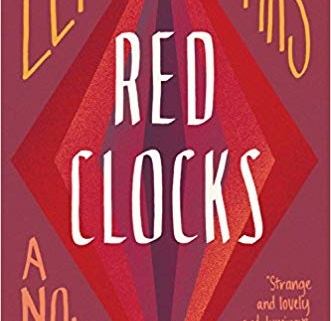Writers Read: Red Clocks by Leni Zumas
 When I was thinking back on how to write up this piece on Red Clocks by Leni Zumas, I kept struggling with the words to put down. How can I best write about a fictitious society that criminalized reproductive rights while we in the US are quite literally on the brink of a collapse of these rights? Perhaps that sounds a bit dramatic, but I read this book months ago and it feels like every week there’s another barrage of #MeToo moments or sexual assault allegations or attacks on reproductive rights. In light of everything happening in our political and societal climate, it becomes much more difficult to separate the facts from this all-too-real fiction. And since Zumas first published this book in January of 2018, it’s not hard to see how this book connects with, and comments on, our reality.
When I was thinking back on how to write up this piece on Red Clocks by Leni Zumas, I kept struggling with the words to put down. How can I best write about a fictitious society that criminalized reproductive rights while we in the US are quite literally on the brink of a collapse of these rights? Perhaps that sounds a bit dramatic, but I read this book months ago and it feels like every week there’s another barrage of #MeToo moments or sexual assault allegations or attacks on reproductive rights. In light of everything happening in our political and societal climate, it becomes much more difficult to separate the facts from this all-too-real fiction. And since Zumas first published this book in January of 2018, it’s not hard to see how this book connects with, and comments on, our reality.
Red Clocks is a fiction novel that is set in a present-day America with one major change: abortions are outlawed and any woman even seeking one is criminalized and charged. Zumas creates a terrifying mirror image of our current society as she weaves the stories and lives of four different women together: The Biographer, The Daughter, The Wife, and The Mender. All four of these people have a specific agenda and dilemma they are facing, but they all stem from the basis of this anti-woman society. Roberta Stephens, The Biographer, struggles with difficulties to conceive a child while fighting to get approved for adoption before a new law passes that will require every child to have two married parents. Mattie Quarles, The Daughter, is isolated and terrified to discover she’s a pregnant teen and has nowhere or no one to turn to. Susan Korsmo, The Wife, is torn between trying to keep her family together for the sake of her kids and needing to leave her husband because she isn’t appreciated and feels lost and without identity. Gin Percival, The Mender, is the woman who lives in the woods and secretly provides herbal remedies and help to women.
On the surface, it might not be obvious exactly how and why all these women are struggling and why the roots of their problems stem from the anti-woman rhetoric. However, in a society that criminalizes women’s sexuality and forces a heteronormative family image, it doesn’t leave much room for support between women. They are all trying to make it in this world that is doing everything it can to make things more difficult and dangerous for them.
Not only that, but this society designates each of them to a certain role within their lives. Throughout the novel, the narration only refers to these four women with their roles or nomenclatures. This reinforces the parameters within which each woman can operate or how they’re viewed in the world. But at the same time, we as readers can see the pushback against some of these roles. Roberta, for example, is a working on a biography of Eivør Minervudottir who was a polar explorer, but she’s also a teacher. She’s working on recording Eivør’s history while directly impacting the futures of those students around her. It’s a reminder that no one ever only has one role or one purpose.
The greatest thing that Zumas does throughout this work is to create four compelling dynamics and lives to showcase just how much this affects everyone. Roberta just wants to have a child, but can’t get pregnant because the one

Leni Zumas
thing that would help her—IVF treatments—have also been outlawed since embryos cannot consent to the procedure. Literal embryos—cells—have more power than a full-grown woman in this society. On the other hand, you might see Susan as someone who’s doing completely fine. She has a husband and family and everything seems good on the surface, but her home life is devastating. She fluctuates between wanting to try and save her marriage, though her husband refuses to even consider going to couples therapy and just leaving him. She’s aware of how much society would blame her for the breakdown of her marriage; she’s also terrified that her children would blame her. We as outsiders can see just how sad and over-worked she is without any help or appreciation from her husband.
Mattie and Gin would be the most obvious examples of why this society is bad because they have the most obviously dire situations. Gin is illegally offering help to women who are struggling with their reproductive rights and health. Mattie is completely alone as she struggles with her pregnancy. It’s through Mattie that we really see how much everyone has to lose here because anyone Mattie tells is not only then implicated and could be jailed and convicted, but they could also turn Mattie in.
This society is so desperately trying to paint itself as the “hero for the unborn,” but it’s completely missing the real and devastating impacts on the actual people in the world. It gives a clear and definitive message that women are not as important because they’re the ones suffering in this world. Gin is arrested and tried for her crimes, but there’s not even a single mention of the fact that she’s been supplementing additional help for women in other ways—just like Planned Parenthood. While Gin does have a tonic that could cause an abortion, she’s also the only person to mention that perhaps Roberta might have polycystic ovary syndrome, which might help explain her troubles at getting pregnant. Roberta had to ask her doctor to run a test because the doctor hadn’t even thought to test her before. Roberta even says at one point that “she is submitting her area to all kinds of invasion without understanding a fraction of what’s being done to it” (14). These new laws have become dangerous and blatantly ignore the health of these women for the sake of having a more “natural” or “traditional” family.
Zumas using these four different women to tell the story of this world helps everyone understand the realities and how it truly does affect everyone. These outrageous laws didn’t happen overnight; they started with small steps that eventually spiraled into the harsh criminalization of women seeking reproductive health and rights. It started with anti-abortion messaging and then criminalized it. That led to the upcoming law, Every Child Needs Two, which states that “unmarried persons will be legally prohibited from adopting children” (37). The slow descent of this society and the rights of the people living here show that no woman is going to be safe forever and that hopefully eventually everyone will begin to take notice of these laws. Roberta herself says that people “forgot about [the law] promptly after hearing it, because the law did not apply to her” (165). Having multiple characters and each having a distinct point of view and story to tell, helped us readers to not ignore others for the sake of our protagonist.
Zumas paints a terrifying example of where we might end up if we continue on this path of criminalizing and punishing women and their sexuality. Women are expected to be ready to raise a child the first time they have sex because we have equated the two so closely in our conservative minds. It’s always shocking to me that no one on the conservative side of this issue ever seems to actually try and understand where these women are coming from. I can only hope that the society described in Zumas’s novel doesn’t come to pass because I truly fear that there might not be a way out for us from there.
Zumas, Leni. Red Clocks. New York, Little Brown and Company, 2018.


 Sara Voigt is a current MFA candidate at Antioch University Los Angeles where she’s pursuing her masters in creative writing. She also works on the literary journal Lunch Ticket, where she’s working as proof edit manager and managing editor. Originally from Wisconsin, she currently lives and works in the Los Angeles area.
Sara Voigt is a current MFA candidate at Antioch University Los Angeles where she’s pursuing her masters in creative writing. She also works on the literary journal Lunch Ticket, where she’s working as proof edit manager and managing editor. Originally from Wisconsin, she currently lives and works in the Los Angeles area.


